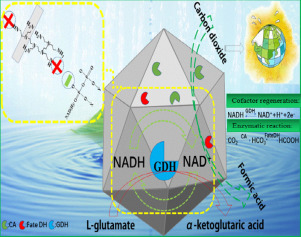当前位置:
X-MOL 学术
›
Int. J. Biol. Macromol.
›
论文详情
Our official English website, www.x-mol.net, welcomes your
feedback! (Note: you will need to create a separate account there.)
Co-immobilization multienzyme nanoreactor with co-factor regeneration for conversion of CO2.
International Journal of Biological Macromolecules ( IF 7.7 ) Pub Date : 2020-03-24 , DOI: 10.1016/j.ijbiomac.2020.03.177 Sizhu Ren 1 , Ziyuan Wang 1 , Muhammad Bilal 2 , Yuxiao Feng 1 , Yunhong Jiang 3 , Shiru Jia 1 , Jiandong Cui 1
International Journal of Biological Macromolecules ( IF 7.7 ) Pub Date : 2020-03-24 , DOI: 10.1016/j.ijbiomac.2020.03.177 Sizhu Ren 1 , Ziyuan Wang 1 , Muhammad Bilal 2 , Yuxiao Feng 1 , Yunhong Jiang 3 , Shiru Jia 1 , Jiandong Cui 1
Affiliation

|
Multienzymatic conversion of carbon dioxide (CO2) into chemicals has been extensively studied. However, regeneration and reuse of co-factor are still the main problems for the efficient conversion of CO2. In this study, a nanoscale multienzyme reactor was constructed by encapsulating simultaneously carbonic anhydrase (CA), formate dehydrogenase (FateDH), co-factor (NADH), and glutamate dehydrogenases (GDH) into ZIF-8. In the multienzyme reactors, cationic polyelectrolyte (polyethyleneimine, PEI) was doped in the ZIF-8 by dissolving it in the precursors of ZIF-8. Co-factor (NADH) was anchored in ZIF-8 by ion exchange between PEI (positive charge) and co-factor (negative charge), and regenerated through GDH embedded in the ZIF-8, thus keeping high activity of FateDH. Activity recovery of FateDH in the multienzyme reactors reached 50%. Furthermore, the dissolution of CO2 in the reaction solution was increased significantly by the combination of CA and ZIF-8. As a result, the nanoscale multienzyme reactor exhibited superior capacity for conversion of CO2 to formate. Compared with free multienzyme system, formate yield was increased 4.6-fold by using the nanoscale multienzyme reactor. Furthermore, the nanoscale multienzyme reactor still retained 50% of its original productivity after 8 cycles, indicating excellent reusability.
中文翻译:

具有辅助因子再生的共固定化多酶纳米反应器,用于转化CO2。
已经广泛研究了将二氧化碳(CO2)转化为化学物质的多种酶。但是,辅因子的再生和再利用仍然是有效转化CO2的主要问题。在这项研究中,通过将碳酸酐酶(CA),甲酸脱氢酶(FateDH),辅因子(NADH)和谷氨酸脱氢酶(GDH)同时封装到ZIF-8中,构建了纳米级多酶反应器。在多酶反应器中,阳离子聚电解质(聚乙烯亚胺,PEI)通过溶解在ZIF-8的前体中而掺杂在ZIF-8中。辅因子(NADH)通过PEI(正电荷)和辅因子(负电荷)之间的离子交换固定在ZIF-8中,并通过嵌入ZIF-8的GDH再生,从而保持了FateDH的高活性。多酶反应器中FateDH的活性回收率达到50%。此外,CA和ZIF-8的结合显着增加了反应溶液中CO2的溶解度。结果,纳米级多酶反应器表现出优异的将CO 2转化为甲酸酯的能力。与游离多酶系统相比,使用纳米级多酶反应器可使甲酸收率提高4.6倍。此外,在8个循环后,纳米级多酶反应器仍保持其原始生产率的50%,表明具有极好的可重复使用性。
更新日期:2020-03-26
中文翻译:

具有辅助因子再生的共固定化多酶纳米反应器,用于转化CO2。
已经广泛研究了将二氧化碳(CO2)转化为化学物质的多种酶。但是,辅因子的再生和再利用仍然是有效转化CO2的主要问题。在这项研究中,通过将碳酸酐酶(CA),甲酸脱氢酶(FateDH),辅因子(NADH)和谷氨酸脱氢酶(GDH)同时封装到ZIF-8中,构建了纳米级多酶反应器。在多酶反应器中,阳离子聚电解质(聚乙烯亚胺,PEI)通过溶解在ZIF-8的前体中而掺杂在ZIF-8中。辅因子(NADH)通过PEI(正电荷)和辅因子(负电荷)之间的离子交换固定在ZIF-8中,并通过嵌入ZIF-8的GDH再生,从而保持了FateDH的高活性。多酶反应器中FateDH的活性回收率达到50%。此外,CA和ZIF-8的结合显着增加了反应溶液中CO2的溶解度。结果,纳米级多酶反应器表现出优异的将CO 2转化为甲酸酯的能力。与游离多酶系统相比,使用纳米级多酶反应器可使甲酸收率提高4.6倍。此外,在8个循环后,纳米级多酶反应器仍保持其原始生产率的50%,表明具有极好的可重复使用性。











































 京公网安备 11010802027423号
京公网安备 11010802027423号